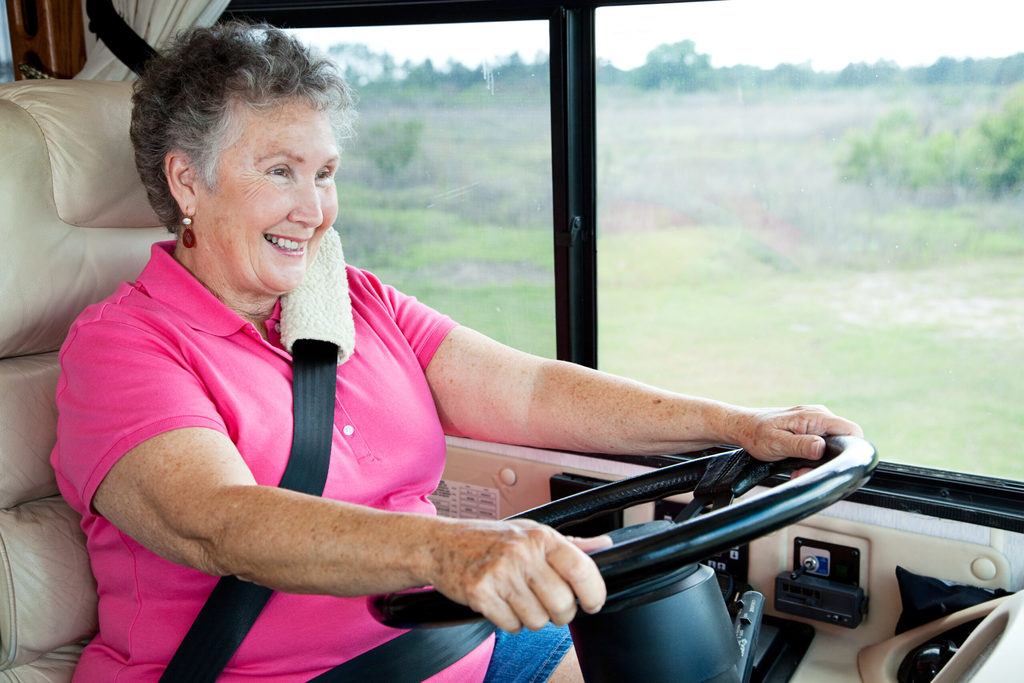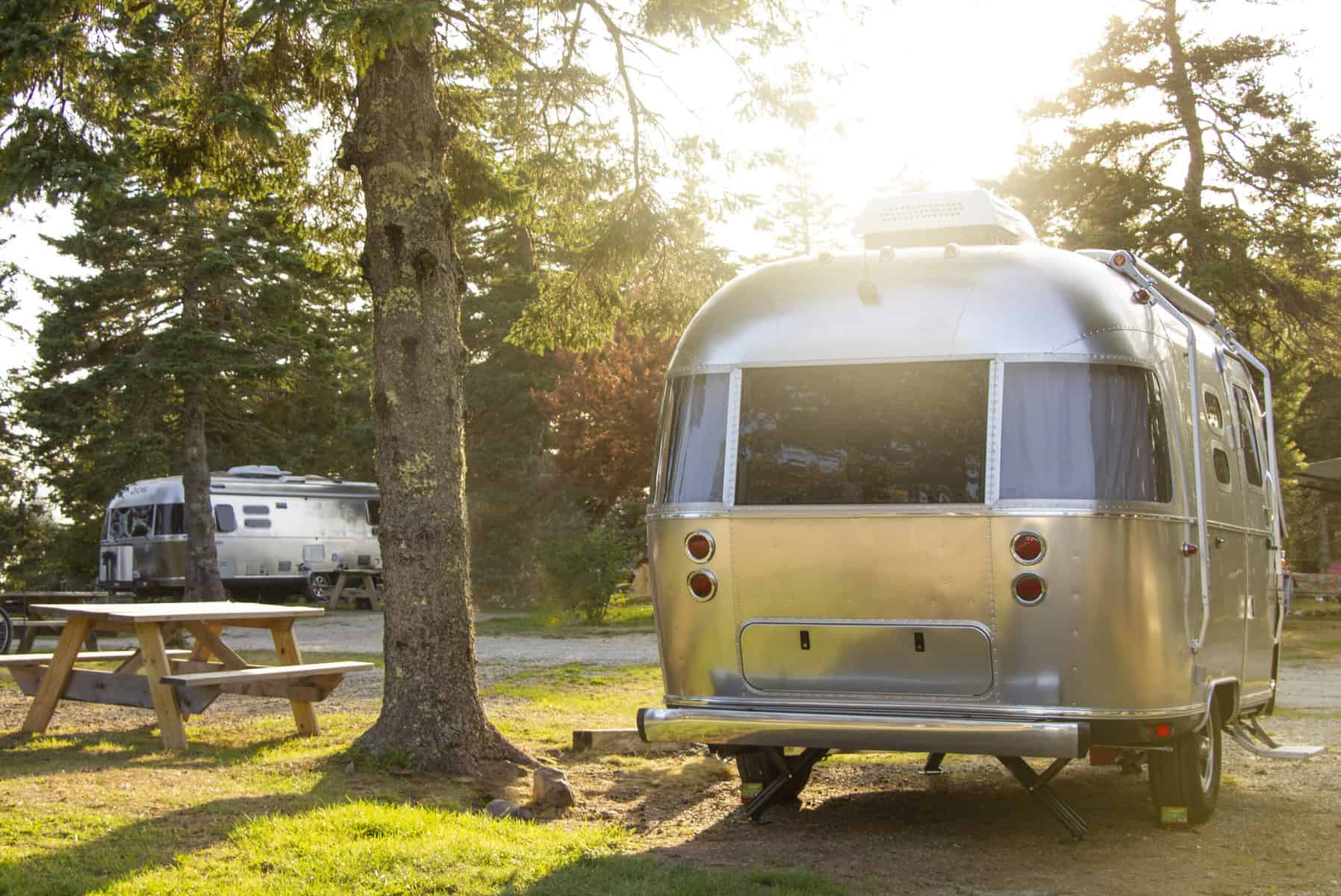RVs are getting easier to drive all the time. But accidents still happen, even to experienced RVers. You can keep the rubber on the road with these safe RV driving tips for new RV owners to long-time nomads.
Whether you buy an awesome small travel trailer or rent an RV for vacations, you are still behind the wheel of a big, heavy vehicle that can do a lot of damage when things go wrong. Lots of RV driving practice, trip planning and cautious driving habits are the best ways to ensure safe handling of your supersized vehicle. For ultimate safety, consider going to RV driving school, and always follow our most essential safe RV driving tips for road trippers.

20 Essential Safe RV Driving Tips
Back your RV in rather than out, as you can more easily maneuver into a tight space going backwards (essentially the same as a vehicle with rear wheel steering). It’s also safer to pull out into traffic going forwards, and you can do it without having to rely on another person to guide you. If you have to back out, make sure you go round and take a good look for low branches, overhangs, or things poking out of the ground that could potentially cause damage.
1. Prepare for roadside emergencies
Carry the right roadside emergencies equipment. If you break down on, pull out emergency flares to signal other drivers.
2. Drive with headlights, day or night
Keep your RV headlights on whatever the time of day to be visible in any conditions. Use hazard lights when going slow up a steep grade, driving an RV on a steep mountain grade, or when temporarily stopped near moving traffic.
3. Minimize your blind spots
Adjust mirrors so that you can just about see the side of your vehicle. This minimizes the size of your blind spot by adjusting convex or fish-eye mirrors so that they include the blind spot. You could have a tailgater that suddenly moves out into traffic and into your lane.
4. Stay out of blind spots
Whether you’re on the freeway or on a multi-lane thoroughfare, stay out of other driver’s blind spots. Pass vehicles quickly and without hesitation.
5. Try two-handed turning
When turning; put one hand on the wheel at the 12 o’clock position and pull down, using the other hand to push up. This gives you a lot more control, and is much safer than one handed steering.

6. Monitor vehicle flow
When your RV is moving, keep an eye on traffic that’s farther ahead. Don’t just watch the tail lights of the vehicle directly ahead of you. This enables you to be more prepared if you have to take preventive action. Multiple brake lights are often a sign of impending danger.
7. Keep your distance from other vehicles
Maintain a five-second gap between you and the vehicle in front. The heavier your RV the more distance and time required for safe stopping.
8. Stay in the slow lane
Drive in the slow right lane as much as possible. Traffic moves slower and it’s more convenient to pull over in an emergency.
9. Prepare to brake
When you approach a changing situation that could become hazardous, cover your brakes. Hover your foot above the brake pedal without actually stepping on it. This enables you to act fast in an emergency.
10. Be alert to road hazards
Watch out for debris on highways and streets. Blown out tires and detritus can cause RV tire blowouts.
11. Learn how to correct your course
If you’re on a tight road and your right wheels leave the asphalt, don’t be tempted to wrench the steering wheel in the opposite direction to correct it. Instead, slow down and gradually steer onto to the road at an angle.
12. Allow faster vehicles to pass you
If a line of traffic builds up behind you, move over to the right as much as possible. Give drivers behind you a clear view of what’s ahead. If possible, pull over to let them pass.
13. Learn how to pass slower vehicles
Is there a tractor in front of you? When you have to pass a slower vehicle on a two lane road, drop back a bit first then accelerate toward it. If it’s clear, pull out and pass the vehicle when you reach it. This ensures you spend the least amount of time in the opposite lane. Never pull out and then accelerate, it’s a time-consuming maneuver.
14. Keep a consistent speed
Driving too fast is an obvious danger. Stay as close to the speed limit as you can and keep consistent speed. Apply that logic to driving too slowly. Impeding traffic can pose its own dangers with impatient car drivers. Going too slow is also a moving violation.
15. Monitor freeway onramp traffic
When traveling in the right lane of a freeway, temporarily move one lane to the left when approaching an onramp. Slightly accelerate to stay ahead of incoming traffic. This enables approaching vehicles to smoothly join the freeway flow.

16. Move over for stalled vehicles
If you see a vehicle parked at the side of the road, move over to the left as much as possible. Give space to stalled vehicles and anyone standing nearby.
17. Stay in your lane
Do not be tempted to cross the solid white traffic control line on the entrance to the freeway. Even if the entrance looks clear, there is a higher chance of a small vehicle or bike being missed resulting in a collision.
18. Don’t be afraid to use your horn
A vehicle’s horn is there to warn drivers if there is a danger of a collision. You can also toot the horn gently when backing up if you do not have a reverse warning beeper.
19. Allow time and space for your freeway exit
When exiting a freeway, move into the far right lane about a mile before your exit. Motorhome driving isn’t like steering a passenger car. Waiting until the last minute can cause unprepared drivers behind you to swerve or hit your rig.
20. Just stay put in bad weather
Don’t drive in bad weather if you can help it. Heavy rain, fog, snow, or ice exponentially increases the risk of RV accidents.
Conclusion
The golden rule of safe RV driving is to drive even more defensively than you would a passenger car. As with most things like knowing how to back up a motorhome or park a travel trailer, driving practice helps you develop your defensive driving skills. The more you hit the road, the faster you can become a skilled, safe, and confident RV driver.



